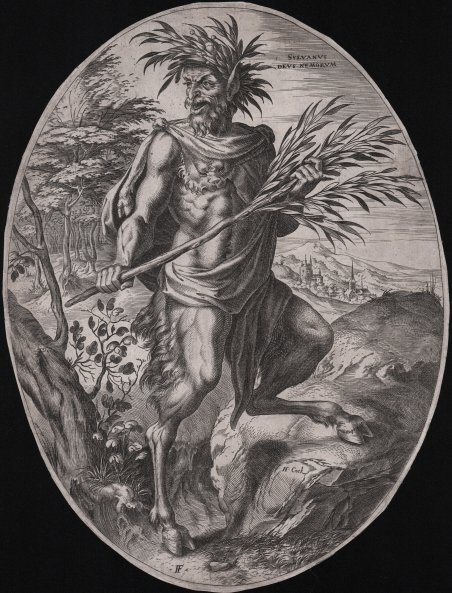Silvano rappresentato a figura intera come un satiro, porta in braccio un ramo d'ulivo; lastra ovale. Bulino, 1565, da un disegno di Frans Floris. Iscrizione in alto a destra "SYLVANUS / DEUS NEMORUM". In basso l’imprint editoriale "H. Cock" e l’autore della composizione, con il monogramma "FF". Da una serie di sei tavole (New Hollstein 166-171) raffiguranti "Divinità rurali", tutte da disegni di Floris, incise da Cornelis Cort per l’editore Cock. Esemplare del primo stato di tre, con l'imprint di Hieronimus Cock. Silvano (Sylvanus) deriva dal dio etrusco Selvans, divinità protettrice della natura e delle attività agresti. Come le divinità antiche della natura selvaggia era considerato temibile e pericoloso per i neonati e le partorienti. Essendo temuto e venerato dai contadini, gli agricoltori erano soliti placare il dio prima di dissodare un terreno, con una triplice cerimonia che ne invocava la protezione sui pascoli, sulle dimore e sui terreni stessi. In origine "Silvanus", era un epiteto del dio Fauno o di Marte e solo successivamente assunse il grado di divinità autonoma. Veniva spesso identificato con Pan o con Sileno, e spesso il suo "numen" si trova accostato alla figura di Marte. Il suo culto era vietato alle donne. Il suo aspetto era umano, ma talvolta veniva raffigurato con cosce e gambe di caprone e corna sulla fronte. Secondo una leggenda, dopo la cacciata da Roma di Tarquinio il Superbo, il dio ammonì l'esercito etrusco (desideroso di riportare il sovrano sul trono), di non attaccare i Romani, mettendolo in fuga. Frans Floris, noto anche come "Raffaello fiammingo", fu in realtà molto influenzato da Michelangelo Buonarroti, che conobbe durante il suo lungo soggiorno in Italia. Pittore e incisore, combinò l'arte del Rinascimento italiano con l'estro della scuola fiamminga, creando una scuola che sarebbe stata seguita fino all'avvento di Rubens. Bella impressione, stampata su carta vergata coeva, rifilata al rame, in ottimo stato di conservazione. Bibliografia New Hollstein (Dutch & Flemish) / The New Hollstein: Dutch and Flemish etchings, engravings and woodcuts 1450-1700 (99.I); Bierens de Haan 1948 / L'oeuvre gravé de Cornelis Cort, graveur hollandais 1533-1578 (169); Van de Velde 1975 / Frans Floris (1519/20-1570), Leven en Werken (60); Riggs 1977 / Hieronymus Cock, Printmaker and Publisher (77); Wouk, Frans Floris / Frans Floris (1519/20-1570): Imagining a Northern Renaissance. (99). Sylvanus, full-length, a satyr carrying an olive branch, oval plate. Engraving, 1565, after Frans Floris. Lettered upper right "SYLVANUS / DEUS NEMORUM". Below "H. Cock" and "FF". From a series of six plates (New Hollstein 166-171) depicting “Rural Gods”. Example of the first state of three, with the imprint of Hieronimus Cock. Silvanus (Sylvanus) is derived from the Etruscan god Selvans, a protective divinity of nature and agrarian activities. Like the ancient deities of wilderness, he was considered fearsome and dangerous to infants and parturients. Because he was feared and revered by farmers, farmers used to appease the god before clearing a plot of land with a threefold ceremony invoking his protection over pastures, dwellings and the land itself. Originally "Silvanus," he was an epithet of the god Faunus or Mars and only later assumed the rank of an autonomous deity. He was often identified with Pan or Silenus, and his "numen" is often found juxtaposed with the figure of Mars. His worship was forbidden to women. His appearance was human, but he was sometimes depicted with goat thighs and legs and horns on his forehead. According to one legend, after Tarquinius the Superb was driven from Rome, the god warned the Etruscan army (eager to restore the ruler to his throne), not to attack the Romans, putting him to flight. Frans Floris, also known as "Flemish Raphael," was actually greatly influenced by Michelangelo Buonarroti, whom he met during his long stay in Italy. A painter and engraver, he combined the art of the Italian Renaissance with the flair of the Flemish school, creating a school that would be followed until the advent of Rubens. A fine impression, printed on contemporary laid paper, trimmed to the platemark, very good condition. Bibliografia New Hollstein (Dutch & Flemish) / The New Hollstein: Dutch and Flemish etchings, engravings and woodcuts 1450-1700 (99.I); Bierens de Haan 1948 / L'oeuvre gravé de Cornelis Cort, graveur hollandais 1533-1578 (169); Van de Velde 1975 / Frans Floris (1519/20-1570), Leven en Werken (60); Riggs 1977 / Hieronymus Cock, Printmaker and Publisher (77); Wouk, Frans Floris / Frans Floris (1519/20-1570): Imagining a Northern Renaissance. (99). Cfr.

Scopri come utilizzare
Scopri come utilizzare

